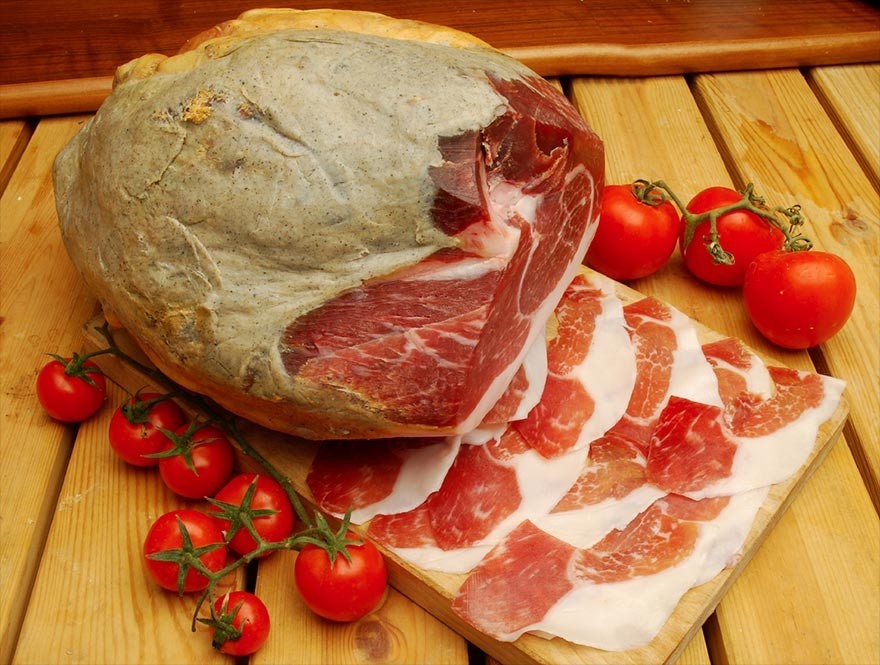Culatello from Zibello P.D.O.
Product description
Culatello di Zibello PDO is a raw and cured charcuterie product wrapped in large-mesh twine netting, obtained from the thigh of pure-bred or hybrids of the Large White, Italian Landrace and Duroc pig breeds.
Production method
Culatello di Zibello PDO is made of the finest muscular fascicles of the leg, the most prestigious part of the deboned thigh.
The muscular mass is dry salted by hand; the salting operation lasts from one to six days.
The sausage is obtained with natural pig casing or pig bladder and is tied manually with several rounds of twine.
Preceding the curing process, the thigh is drained for about a week and then left to dry for 30-60 days. The curing of the product, which must last for over 10 months, must take place in environments that ensure sufficient exchange of air and a temperature of 13-17°C.
Apparence and flavour
Culatello di Zibello PDO is pear-shaped and weighs 3-5 kg. On cutting, it has a uniform red colour and the fat between the various muscular fascicles is white.
The fragrance is intense and characteristic and it has a mild, sweet and delicate flavour.
Gastronomy
Culatello di Zibello PDO is preserved by basting olive oil and butter onto the skin and then wrapping the entire product in a linen cloth.
It should then be kept in a cool place, but not in the fridge. The cloth should be removed before slicing, and with the help of a sharp knife,
the external impurities should be removed. The slice should be thin and the product should be eaten over a short period of time, in order to fully appreciate its organoleptic properties.
Culatello di Zibello PDO is best served with the characteristic bread of the area and butter, accompanied by a dry, yet not too aromatic sparkling wine.
Marketing
The product is marketed as Culatello di Zibello PDO. It is sold whole, in pieces or freshly sliced to order.
Distinctive features
Culatello di Zibello PDO is part of the gastronomic and cultural heritage of the production area, which runs alongside the River Po, where the climatic characteristics influence the curing of the product in a determining way, defining its unmistakeable organoleptic properties.
History
Culatello di Zibello PDO has deep historical roots in the memory of rural culture.
It is documented that Culatelli were already appreciated in 1332, when they were given as a gift to the newly-weds at the wedding banquet of Andrea dei Conti Rossi and Giovanna dei Conti Sanvitale.
The first official citation dates back to 1735, in a document written by the Parma Town Council.
During this period Culatello was probably a used as a Royal gift: a pledge that loyal subjects paid to their Lords.
Moreover, this tribute could have been full of symbolic meaning: an exchange of “investiture”.
In fact, the Culatello was “invested”, covered and tied tightly in the pig bladder or casing.
The first literary references can be traced back to the XVIII century, in a work by Parma poet Giuseppe Callegari, who in one of his short stories,
cited two Parma specialities as being among those which were “important in Heaven”.
During the same period, the sculptor Renato Brozzi exchanged opinions on the Culatello with the poet Gabriele D’Annunzio.
Production area
The production area of Culatello di Zibello PDO is within the territory of the municipal areas of
Polesine, Busseto, Zibello, Soragna, Roccabianca, San Secondo, Sissa and Colorno, in the Province of Parma, in the Emilia-Romagna region.
The pigs used for the production must come from breeding farms situated in the regions of Lombardy or Emilia- Romagna.
Operators: 22
Production(KG): 246.00
Turnover(MLN€): 8,05

 IT
IT 